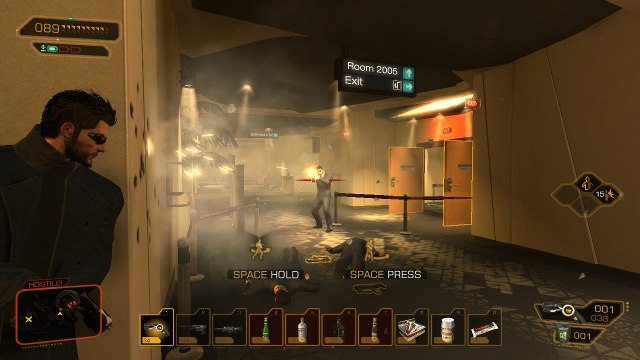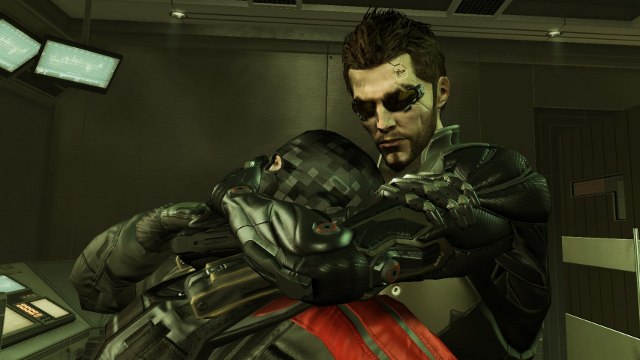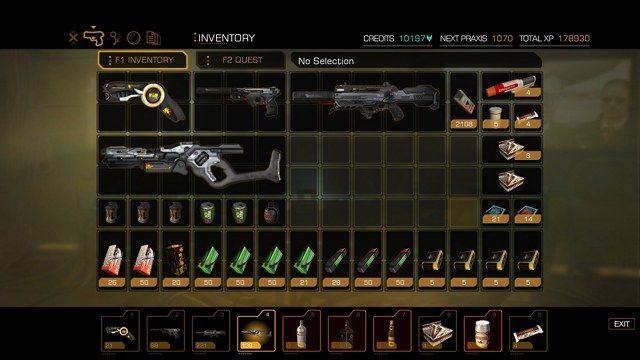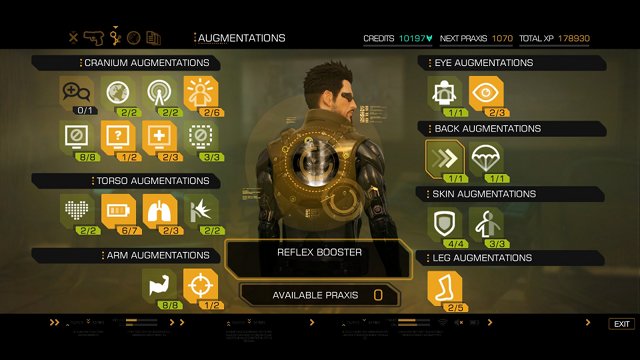Deus Ex: Human Revolution lives up to its legacy

There’s no denying that I'm a huge fan of the original Deus Ex. Released almost eleven years ago, this title pretty much defined how a crossbreed between first person shooter and role playing experience should play like. The game’s branching storyline with a strong focus on player choice, its dystopian near-future setting and gameplay mechanics that strayed far from the linear nature of other shooters made Deus Ex one of the most acclaimed titles released in the last decade – and rightfully so.
Considering that the 2003 sequel, Deus Ex: Invisible War – while not a bad game by itself – couldn't quite live up to the high expectations set by its predecessor, I was all the more excited to see the series’ newest installment, Deus Ex: Human Revolution being received with almost universal acclaim. While I usually manage to resist the urge to buy games at full price, the promise of a yellow-tinted re-imagination of the Deus Ex universe was just a bit too tempting. Now that I’ve completed my first playthrough, I’d like to lose a few words on my impression of how well Human Revolution measures up – not only against the original, but also against today’s genre standards.
A world to live in
Human Revolution takes place in the year 2027, roughly 25 years before the events of the original Deus Ex. True to the franchise’s cyberpunk setting, its vision of the future is not exactly utopian: Powerful international corporations have taken over many of the responsibilities previously fulfilled by governments, the gap between rich and poor is widening continuously and the consequences of global warming have turned into a very real threat to a considerable part of the population. Despite these bleak circumstances, technology has advanced in great strides, leading up to a point where even the wealthy have little choice other than to artificially “improve” their bodies and minds with implants in order to keep up with the demands of this highly competitive society. However, enhancing one's abilities with these so-called augmentations not only comes at the price of a life-long dependence on immunosuppressive medications, but it also carries a considerable stigma in the eyes of a semi-religious anti-augmentation movement.
You take the role of Adam Jensen, an ex-cop, who – after some troublesome events in his previous career – now works as chief of security for Sarif Industries, one of the leading manufacturers of human augmentations. Just as Sarif was preparing to announce a breakthrough in augmentation research, their labs are attacked by mercenaries of unknown affiliation. The prologue ends as Jensen’s attempt to interfere goes awry and he is left for dead on the lab’s burning premises.
 Jensen should have become suspicious when they
installed built-in sunglasses as part of the life saving
surgery.
Jensen should have become suspicious when they
installed built-in sunglasses as part of the life saving
surgery.Unlike most of his fellow employees at the lab, however, Jensen is saved at the cost of sacrificing considerable parts of his body for artificial counterparts. Six months after this involuntary transformation, he is called back into action as another attack strikes an off-site research facility. Determined to find out who is behind the assaults, Jensen is about to face an overarching conspiracy unraveling in a globe-trotting search for the truth.
To shoot or not to shoot
At first glance, Deus Ex: Human Revolution plays like a solid first-person shooter, but with a plethora of additional mechanics. While both, the original Deus Ex and its sequel never left the first-person perspective except for showing dialogs, Human Revolution introduces a cover system that makes the camera pop out into a third-person view as soon as Jensen takes cover. Hiding behind walls or sufficiently large objects not only offers protection from gunfire, but also provides a wider field-of-view that allows you to scout your surroundings without the risk of being detected. Moving around behind cover and hopping from one barricade to another works smoothly and enables you to confuse your opponents while moving into a favorable position for blindfiring at them or quickly popping out to take aimed shots.

Fortunately, the cover mechanics are not just a mere attempt at adopting modern genre standards, but rather turn out to be an absolute necessity once bullets start flying in your direction. Even though Jensen slowly regenerates from the injuries he suffers, he is still a human being and thus can’t take more than two or three hits before going down. This also means that – at least on the highest difficulty setting – careful planning is a must, even if you choose to play aggressively.
Of course, this wouldn’t be a Deus Ex title if combat couldn’t be avoided altogether throughout most of the game. Sneaking past your opponents is almost always a viable option, thanks to the fact that the designers took care to provide an abundance of different paths leading to each mission objectives. If you prefer a stealthy approach, entering a building through the roof or a sewer access might be preferable to marching right through the main entrance, but even if you are detected, there’s always a dark corner or an air duct to hide in. Alternatively, closing in on enemies (or letting them close in on you) allows you to perform a takedown that will instantly incapacitate or kill them with a quick (and beautifully choreographed) melee attack. Non-lethal takedowns produce less noise than lethal ones, but they are also less permanent due to the fact that – unlike in the original Deus Ex – incapacitated enemies can be woken up by their buddies.

Speaking of enemy AI, it is worth mentioning that this is one aspect that has improved considerably compared to the original. While enemy guards still follow predetermined patrol paths, they now act a little more unpredictable and a lot more natural by looking around or suddenly turning to check what’s behind their backs. It’s always a good idea to hide bodies of fallen opponents, because once they are spotted (either by a patrolling opponent or a camera), most of the remaining enemy force will be alarmed of your presence.
While relying on stealth is a viable tactic throughout most of Human Revolution, it is worth mentioning that there are moments where you are forced to resort to violence: The game’s much loathed boss fights. Following a design decision that breaks with the premise of free-form gameplay, Human Revolution’s boss encounters strip you of all options except for the one that is one-on-one combat. Given that the boss fights have been subject to scathing criticism, I was a bit surprised that I found them rather enjoyable. – but even if you don’t, you’ll be glad to hear that they are not only few and far between, but also fairly easy even if you’re playing a stealth oriented character.
For players that don’t intend to avoid enemy contact, Human Revolution offers a huge assortment of weapons to choose from. In addition to a standard fare of pistols, shotguns, and various rifles, Jensen will also stumble upon more exotic armaments like a laser rifle that burns through walls or the non-lethal P.E.P.S. gun which knocks entire groups of enemies off their feet. Considering that most of the weapons are also upgradeable in various ways, you’ll probably stick with a few tools of choice throughout most of the game rather than experimenting with different loadouts – especially since the limited inventory space would otherwise force you to drop an already upgraded weapon just to try out a new one. A bit more inventory space (or weapons that take less of it) would have been nice.

Pheromones to the rescue!
Weapons are not the only thing that is upgradeable in Human Revolution: Faithful to the tradition of allowing a certain degree of character customization, Jensen gradually gains new abilities as his body adapts to its artificial limbs and organs. Gameplay-wise, this process is implemented through experience points earned for pretty much any successfully performed action, be it knocking out an enemy, hacking a terminal or simply finding a hidden passage. Every time a certain amount of XP are accumulated, a new ability can be picked from a tree of augmentation upgrades. Just like in Invisible War, there is no skill system, making the augmentation tree only way to customize your characters abilities.

Although some of the upgrades simply enhance existing skills by improving your aim or increasing sprint duration, there are a few really interesting ones as well: The Icarus landing system, for example, allows you to jump from arbitrary heights without incurring falling damage. On the rare occasions where its usage makes sense tactically, jumping down on unsuspecting opposition makes for great gameplay moments. Improving the arm prostheses to a degree where you can break through weak spots in walls or lift heavy objects opens up the way to hidden passages, while the cloaking system conceals your movements even from the most vigilant observers. Upon activation, many of the augmentations eat away at your energy meter which is separated into multiple bars, only the first of which regenerates over time. Filling up your energy reserve in full requires constant nibbling on consumables, which gets a bit tedious over time.
Considering that not even Jensen’s brain is free of implants, there are also augmentations designed to help with two gameplay elements that haven’t been discussed yet: Hacking and social interaction. The hacking mini-game is a bit hectic, but never to a degree where it stops being fun – an achievement in its own right, considering that its in-game purpose is limited to granting access to terminals, security hubs and previously locked doors when Jensen doesn’t know the corresponding passwords. Thankfully, there’s also quite a bit of hidden content to uncover, including hilarious email conversations that add a lot of personality to your otherwise nameless opponents.
Dialogues also play an important role in Human Revolution. Even though typical NPC conversations only give you a very limited set of choices on how Jensen reacts to his counterpart, there are a few key dialogues that are considerably more elaborate. These are usually triggered at important moments in the plot, typically when Jensen tries to convince someone of acting against his or her own interest. I found these arguments highly entertaining, especially since they provide enough subtle hints as to which persuasion tactic will be successful. If that’s not enough, there’s also an augmentation that gives you additional leverage – and even allows you to spray a few pheromones for good measure. Personally, I deemed using the (aptly named) “social enhancer” hardly necessary, considering that even without installing it, I was able to succeed at all but one of the “dialogue battles” in the first attempt.
All in all, Human Revolutions’s gameplay mechanics seem like a solid foundation to build upon. Other than the energy management, which can get a bit annoying at times, there’s not a single aspect of the game that feels broken or badly designed. The shooting mechanics and cover system are functional and fun, the stealth aspect is thrilling and the dialogue battles are among the most suspenseful gameplay moments I’ve ever had the joy of experiencing. Yet, being a story-driven single-player game, Human Revolution needs more than just polished gameplay mechanics in order to be a convincing title.
A shiny dystopia
While Human Revolution’s presentation isn’t flawless from a technical perspective, its distinct visual style with recurring motifs and a rather unique color scheme works hard to make up for it. As it is apparent from the screenshots alone, the game’s vision of our bleak future is almost exclusively painted in different shades of yellow – an artistic choice that doesn’t fail to convey the dreariness of the populous cities and industrial complexes visited throughout the game.

The overall feeling invoked by strolling through a bustling metropolis bathed in yellow neon light is – intentionally, I presume – reminiscent of genre-defining works like Blade Runner. Nods to this particular movie are even more apparent in the recurring origami theme that manifests in the game’s vision of future architecture, fashion and industrial design. As an additional cue, Human Revolution’s premise of a society at the brink of a fundamental transformation finds its expression in the ubiquity of renaissance motifs.
Given how hard it must have been to craft this beautiful world, it is all the more unfortunate that, due to technical limitations, the game struggles and sometimes fails to uphold the player’s illusion of actually being part of it. While it’s true that the cities depicted in the game no longer feel as empty as they did in the game’s predecessors, it is also very apparent that most of the people you encounter aren’t doing anything other than standing around or strolling back and forth on pre-defined paths. Trying to interact with non-essential NPCs will just cause them to greet you with one of many one-liners, which – paired with the robot-like facial animation – contributes little to the game’s immersiveness and makes you wish it would do a better job at pointing out those NPCs that provide actual dialogue.
The plot thickens. Constantly.
The conspiracy-laden plot is certainly one of the things that the original Deus Ex is most famous for – and it’s a trait well preserved in Human Revolution. That said, I’m under the impression that not only the ridiculousness, but also the overall complexity of the plot has been toned down a little – which is a good thing, considering that the game certainly doesn’t feel dumber for it. The overarching theme of transhumanism and its implications for both, human identity and society as a whole, is treated in a down-to-earth manner that only hints on the underlying philosophical questions instead of imposing them on players. The game portraits a number of fairly radical standpoints, but somehow manages to never take side with any of them explicitly. Considering that most of the portrayed ideologies are contrary to each other at a fundamental level, this is an accomplishment of its own.
Unfortunately, as a consequence, the player’s ability to side with any of the factions is also rather limited. While choice is indeed a big factor for how the game plays, its impact on the actual plot is minor at best. There’s no denying that story-wise, Human Revolution is not so much about choice as it is about giving the illusion of choice, since – again, like the original Deus Ex – the game will ultimately follow a fairly linear path regardless of your actions. Occasionally, however, in-game characters do react to the way you resolved a particular situation and there’s at least one point where a certain decision has dire consequences much later in the game. These moments are great – it’s just sad that there aren’t more of them.
Verdict
Deus Ex: Human Revolution succeeds at copying the positive traits of its archetype while avoiding many, but not all of its missteps. The fact that it suffers from numerous small annoyances ultimately can’t eclipse the quality of its core gameplay and art design. Blessed with a great setting and a plot that is genuinely interesting (if a bit corny at times), Human Revolution is a game that nobody should want to miss. If you enjoyed the original even a little bit, you most certainly won’t be disappointed by this one.
